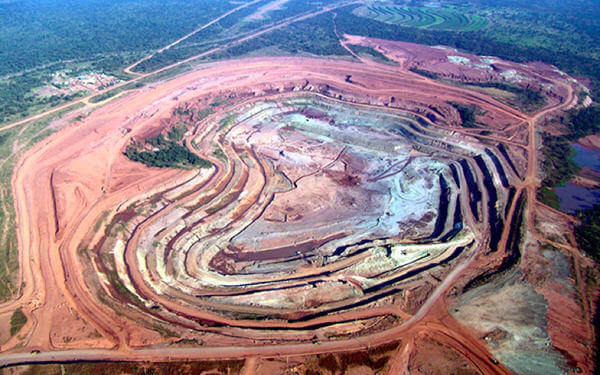
Coming off of 2017, a year in which global diamond supply by volume increased by 11.7% year-over-year, supply is forecast to contract by 3.4% to 147M carats in 2018 (see appendix at bottom for itemized analysis by mine).
Out of the world’s top three diamond miners by volume, only De Beers is expected to increase production this year, while diamond output at Russia’s ALROSA (MICEX: ALRS) and diversified-major Rio Tinto (LSE: RIO) is estimated to decline, more than offsetting De Beers’ increase. Combined, the three companies represent approximately 70% of global diamond supply by volume.
De Beers
Company-wide, De Beers is estimated to produce 34.6M carats worth $5.7B in 2018 which is enough to maintain its status as industry-leader in terms of value produced. The production volume figure represents a modest 1.2M carat increase year-over-year, with the boost expected to primarily come from the company’s Jwaneng mine in Botswana, the richest diamond mine in the world in terms of value produced. In 2018 Jwaneng is estimated to produce 13.5M carats worth $2.7B, which compares to 11.9M carats worth $2.3B in 2017. The mine by itself represents 17% of global diamond supply by value on an annual basis and with an estimated resource of over 350M carats, it has a remaining mine-life of 25 years.
At current estimates, De Beers would be producing at approximately 95% of production capacity in 2018, which compares to 91% last year and only 80% in 2016. De Beers’ strategy of “producing to demand” over the past two years has reduced the company’s excess inventory to more normal levels. With as much as 12M carats of excess inventory on hand at year-end 2015, the company now only holds 3-4M carats over minimum operating levels, the lowest figure since 2014, according to estimates.
At the moment, De Beers marketshare by value produced and sold is 37%, which is down from 45% a decade ago and down from over 80% in the late-1980’s, before the industry structurally changed. With no new advanced-stage kimberlite projects in the works and with production close to capacity, it is unlikely that the company’s market share will significantly revert to higher levels in the short-to-medium term without an acquisition, which even then would be limited by antitrust restrictions.
ALROSA
ALROSA is estimated to be the world’s largest producer by volume in 2018, with an output of 36.6M carats. However, this would be down from 39.5M carats last year. The year-over-year production decrease can be attributed to lost production at the company’s Mir mine following a flooding accident last summer but also a decrease in production at the Jubilee mine, a result of normal depletion.
Mir produced 2.8M carats last year prior to the accident and 3.2M carats in 2016. In an investor presentation from January 2018, ALROSA accounts for zero production from the Mir mine through 2020. Jubilee has been ALROSA’s largest producing mine by volume for the last two years, however, production is estimated to decrease from 10.1M carats last year to 8.2M carats this year, and decline further to 5.9M carats in 2019 on decreasing grade.
Offsetting some of the lost production at Mir and Jubilee will be the commencement of production at the company’s newest mine, Verkhne-Munskoe, which will begin commissioning later this year, and ramp up to 1.8M carats of commercial production annually by 2020.
Similar to De Beers, ALROSA has reduced excess inventory levels in recent years, and currently sits at its lowest level of inventory since 2014, estimated at approximately 17-18M carats. Compared to the company’s minimum operating inventory of approximately 13M carats, ALROSA’s current implied excess inventory level is about 4-5M carats. ALROSA has hinted that the company’s sales plan in 2018 is 41M carats, which relative to 2018 production guidance of 36.6M carats, implies a flush-out of the remainder of excess inventory this year.
Not included in the production and sales figures above, ALROSA also holds a 41% stake in the Catoca joint-venture. The partnership operates the Catoca mine in Angola, which is estimated to produce 6.7M carats this year, and is also developing the industry’s most prospective new project, Luaxe, which is estimated to be a top-5 ranking mine globally (by production volume) when it finally commences full production sometime after 2022. As a note, ALROSA does not receive in-kind production from the Catoca partnership.
Rio Tinto
The industry’s third largest producer by volume is diversified mining major Rio Tinto. Rio only has interest in two producing diamond mines, its 100%-owned Argyle mine in Australia and a 60% stake in the Diavik mine in Canada. By volume, 76% of the company’s net production is estimated to come from Argyle, which is largest mine in the world in terms of carat volume produced. The majority of the mine’s production is low-quality in size and color, and the mine’s economics are driven by the occurrence of fancy pink diamonds which fetch a significant premium to white and most other fancy colored stones. In 2018, Argyle’s production is expected to decrease by 3M carats year-over-year to 14M carats.
Supply/Demand
With global diamond production expected to decrease in 2018 along with producer inventories at multi-year lows, a demand increase should allow for diamond price upside. A 2-4% increase in diamond demand is quite possible this year given the backdrop of a strong global economy, healthy U.S. consumer sentiment, signs of a stronger Mainland Chinese market, and the Diamond Producers Association increased budget fueling the return of generic diamond marketing. This scenario could translate to a real 3-5% increase in rough and polished prices this year.
Source: Mining.com